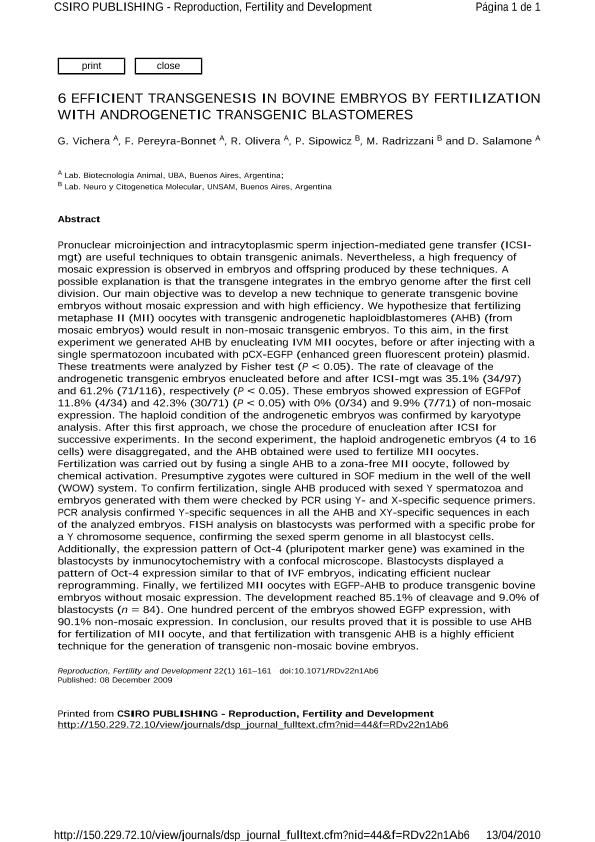Artículo
6 efficient transgenesis in bovine embryos by fertilization with androgenetic transgenic blastomeres
Vichera, Gabriel Damian ; Pereyra Bonnet, Federico Alberto
; Pereyra Bonnet, Federico Alberto ; Olivera, Ramiro; Sipowicz, Pablo; Radrizzani Helguera, Martin
; Olivera, Ramiro; Sipowicz, Pablo; Radrizzani Helguera, Martin ; Salamone, Daniel Felipe
; Salamone, Daniel Felipe
 ; Pereyra Bonnet, Federico Alberto
; Pereyra Bonnet, Federico Alberto ; Olivera, Ramiro; Sipowicz, Pablo; Radrizzani Helguera, Martin
; Olivera, Ramiro; Sipowicz, Pablo; Radrizzani Helguera, Martin ; Salamone, Daniel Felipe
; Salamone, Daniel Felipe
Fecha de publicación:
01/2010
Editorial:
Csiro Publishing
Revista:
Reproduction Fertility and Development
ISSN:
1031-3613
Idioma:
Inglés
Tipo de recurso:
Artículo publicado
Clasificación temática:
Resumen
Pronuclear microinjection and intracytoplasmic sperm injection-mediated gene transfer (ICSI-mgt) are useful techniques to obtain transgenic animals. Nevertheless, a high frequency of mosaic expression is observed in embryos and offspring produced by these techniques. A possible explanation is that the transgene integrates in the embryo genome after the first cell division. Our main objective was to develop a new technique to generate transgenic bovine embryos without mosaic expression and with high efficiency. We hypothesize that fertilizing metaphase II (MII) oocytes with transgenic androgenetic haploidblastomeres (AHB) (from mosaic embryos) would result in non-mosaic transgenic embryos. To this aim, in the first experiment we generated AHB by enucleating IVM MII oocytes, before or after injecting with a single spermatozoon incubated with pCX-EGFP (enhanced green fluorescent protein) plasmid. These treatments were analyzed by Fisher test (P < 0.05). The rate of cleavage of the androgenetic transgenic embryos enucleated before and after ICSI-mgt was 35.1% (34/97) and 61.2% (71/116), respectively (P < 0.05). These embryos showed expression of EGFPof 11.8% (4/34) and 42.3% (30/71) (P < 0.05) with 0% (0/34) and 9.9% (7/71) of non-mosaic expression. The haploid condition of the androgenetic embryos was confirmed by karyotype analysis. After this first approach, we chose the procedure of enucleation after ICSI for successive experiments. In the second experiment, the haploid androgenetic embryos (4 to 16 cells) were disaggregated, and the AHB obtained were used to fertilize MII oocytes. Fertilization was carried out by fusing a single AHB to a zona-free MII oocyte, followed by chemical activation. Presumptive zygotes were cultured in SOF medium in the well of the well (WOW) system. To confirm fertilization, single AHB produced with sexed Y spermatozoa and embryos generated with them were checked by PCR using Y- and X-specific sequence primers. PCR analysis confirmed Y-specific sequences in all the AHB and XY-specific sequences in each of the analyzed embryos. FISH analysis on blastocysts was performed with a specific probe for a Y chromosome sequence, confirming the sexed sperm genome in all blastocyst cells. Additionally, the expression pattern of Oct-4 (pluripotent marker gene) was examined in the blastocysts by inmunocytochemistry with a confocal microscope. Blastocysts displayed a pattern of Oct-4 expression similar to that of IVF embryos, indicating efficient nuclear reprogramming. Finally, we fertilized MII oocytes with EGFP-AHB to produce transgenic bovine embryos without mosaic expression. The development reached 85.1% of cleavage and 9.0% of blastocysts (n = 84). One hundred percent of the embryos showed EGFP expression, with 90.1% non-mosaic expression. In conclusion, our results proved that it is possible to use AHB for fertilization of MII oocyte, and that fertilization with transgenic AHB is a highly efficient technique for the generation of transgenic non-mosaic bovine embryos.
Palabras clave:
Transgenic
,
Androgenetic
,
Bovine Embryos
,
Haploid
Archivos asociados
Licencia
Identificadores
Colecciones
Articulos(SEDE CENTRAL)
Articulos de SEDE CENTRAL
Articulos de SEDE CENTRAL
Citación
Vichera, Gabriel Damian; Pereyra Bonnet, Federico Alberto; Olivera, Ramiro; Sipowicz, Pablo; Radrizzani Helguera, Martin; et al.; 6 efficient transgenesis in bovine embryos by fertilization
with androgenetic transgenic blastomeres; Csiro Publishing; Reproduction Fertility and Development; 22; 1; 1-2010; 161-161
Compartir
Altmétricas



